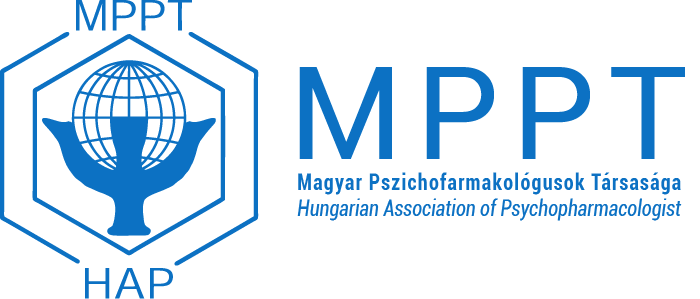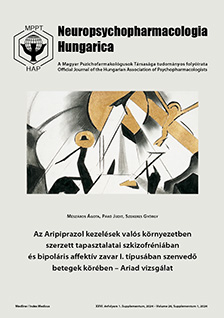Volume 26, Supplement 1. 2024
Real-world experience of aripiprazole treatment in patients suffering from schizophrenia and bipolar affective disorder type I – Ariad study
Ágota Mészáros, Judit Pákó, György Szekeres
Abstract
The partial D2 receptor agonist aripiprazole, initially referred to as a third-generation antipsychotic, has been widely used in the treatment of schizophrenia and later bipolar affective disorder in many countries since the 2000s. Objective: In the present non-interventional study among psychiatrists, we aimed to collect real world data (RWD) data on experiences gained with aripiprazole treatments under domestic real-life conditions. During the three-month follow-up, we examined remaining on therapy and patient cooperation as primary goals, and we also analyzed the characteristics of the patients undergoing treatment, the most typical therapeutic decisions for each disease, the effectiveness and safety of the product under real-life conditions, and the practice of aripiprazole blood level determination supporting personalized treatment. Patients and methods: The open-label, multicentre, prospective study included a total of 414 patients of 34 psychiatrists over 18 years of age with schizophrenia (SCH) (n=237) or bipolar affective disorder (BPZ) type I (n=177) whose aripiprazole (10mg, 15mg and 30mg) treatment was set according to the summary of product characteristics, independent of the study. Data were recorded when the patient was enrolled and after 1 and 3 months. Patient cooperation was evaluated by physicians and also by patients, using a self-assessment questionnaire (Morisky Green Levine /MGL). Clinical Global Impression – Severity (CGI-S) scale was used to assess disease severity, and Clinical Global Impression – Improvement (CGI-I) to assess changes in the disease severity. The development of cognitive function was investigated based on the components of the Positive and Negative Syndrome Scale (PANSS) cognition/desorganization. Results: 99.3% of the 414 patients remained on aripiprazole throughout the 12-week study period, only 3 discontinued. Physicians assessed patients’ adherence “seemingly trouble-free” to aripiprazole treatment in 74.8% (SCH: 73.3%; BPZ: 76.8%) after 1 month and in 76.8% (SCH: 72.9%; BPZ: 82.2%) after 3 months. Based on MGL self-assessment questionnaires completed by patients, 55.4% of patients (SCH: 56.5%; BPZ: 53.8%) belonged to the high adherence group after 1 month and 57.2% (SCH: 54.9%; BPZ: 60.5%) after 3 months. 76% of patients were taking aripiprazole alone as an antipsychotic. 29% of schizophrenic patients and 18% of people with bipolar affective disorder received the drug in combination with other antipsychotics. 51% of patients with bipolar affective disorder received concomitant mood stabilizing treatment. Based on CGI-I values, 74.1% of patients improved much or very much after 3 months. Gradual improvement was also observed in the cognition/desorganization components of PANSS in both patient groups. Patients well-tolerated the medication. Adverse reaction happened in only 10 cases, these were predominantly mild. Aripiprazole blood levels were not measured during treatments. Conclusions: The effectiveness, favorable side effect profile, good tolerability and the strenghtened doctor-patient relationship experienced under real-life conditions in outpatient care may all have played a role in staying on therapy at an even higher rate than expected, maintaining good adherence, and consequent good efficiency. Aripiprazole blood level determination and the related personalized treatment approach are currently not part of daily practice in Hungary.
Keywords: aripiprazole, schizophrenia, bipolar affective disorder, real life study, adherence, efficiency



